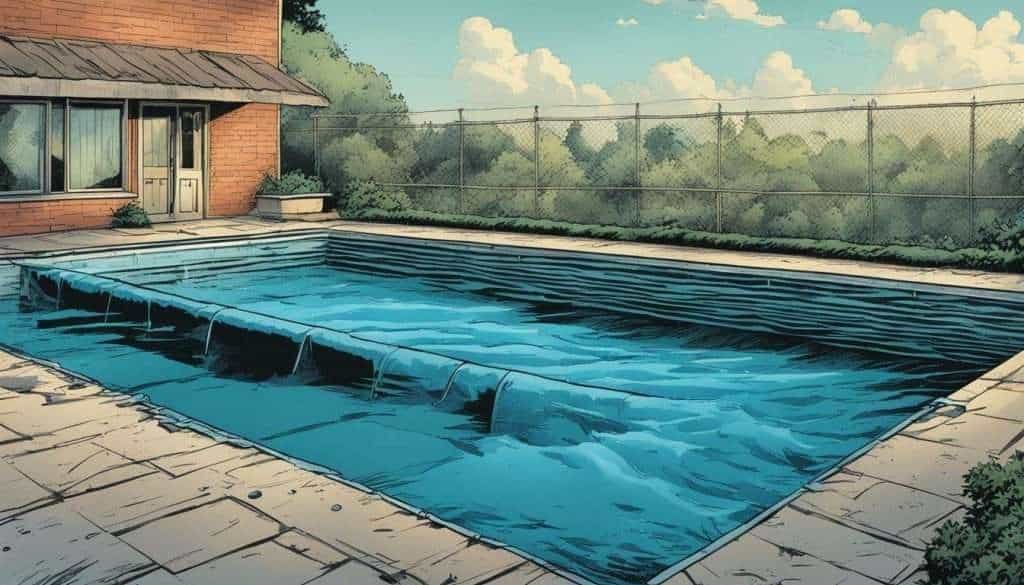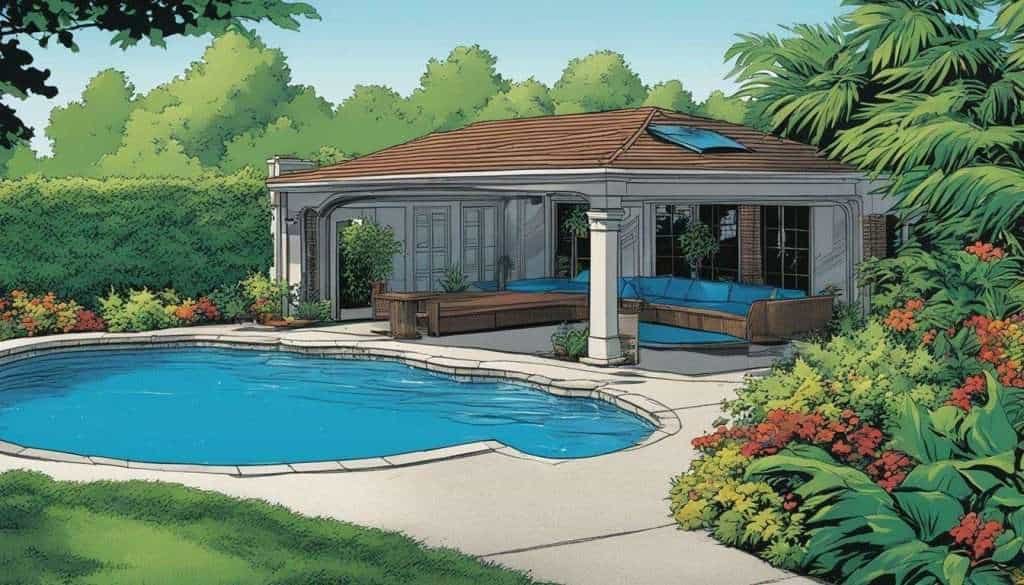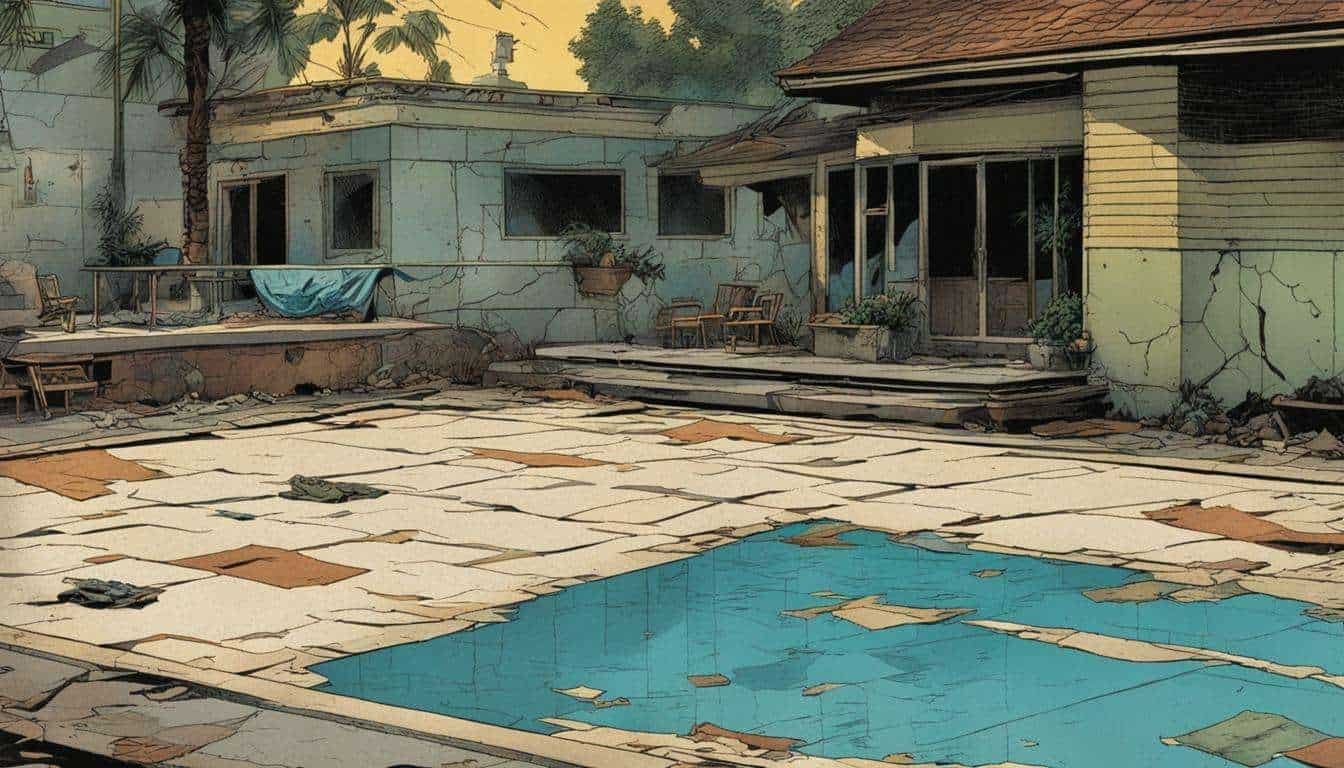When considering the lifespan of a swimming pool cover, it’s important to understand that various factors come into play. The quality of the cover, the type of material used, and the level of sun exposure can all impact how long a pool cover will last.
Swimming pool covers are designed to protect your pool from debris, minimize evaporation, and maintain water temperature. However, over time, wear and tear can occur, reducing the effectiveness of the cover.
Key Takeaways:
- The lifespan of a swimming pool cover can vary depending on factors such as the quality of the cover, the type of material used, and the level of sun exposure.
- Vinyl pool covers with maximum sun exposure may last only a year, while automatic pool covers can last anywhere from 3 to 7 years.
- Regularly inspect your pool cover for tears, stiffness, brittleness, discoloration, stains, or mold.
- Consult a pool maintenance professional to determine when it’s time to replace a worn-out pool cover.
- Proper maintenance and care can help prolong the lifespan of your swimming pool cover.
Factors Affecting Pool Cover Durability
The lifespan of a swimming pool cover is influenced by several factors, including the quality of the cover, the material it’s made of, and the amount of sun exposure it experiences. These factors can greatly impact the durability and longevity of your pool cover, ultimately affecting how long it will last before needing replacement.
The quality of the cover is crucial in determining its durability. Investing in a high-quality pool cover made from durable materials will generally result in a longer lifespan. Covers made from thicker and stronger fabrics are more resistant to tears, UV damage, and the wear and tear of regular use. Additionally, reinforced webbing and sturdy seams are important features to look for as they contribute to the overall strength and durability of the cover.
The material used in the construction of the cover also plays a significant role in its lifespan. Different materials have varying levels of resistance to UV rays, which can cause the cover to become brittle, fade, or deteriorate over time. Vinyl covers, for example, are susceptible to sun damage and may only last a year when exposed to maximum sun exposure. On the other hand, automatic covers made from durable fabric materials can withstand the elements and can last anywhere from 3 to 7 years.
The amount of sun exposure that a pool cover receives is another important factor to consider. Continuous exposure to harsh sunlight can accelerate the aging process of the cover, causing it to deteriorate more quickly. If your pool is located in an area with high sun exposure, it’s essential to choose a cover with a higher resistance to UV rays. Alternatively, consider using a cover that provides shade to minimize direct sunlight exposure.
Table: Average Lifespan of Different Pool Cover Materials
| Pool Cover Material | Average Lifespan |
|---|---|
| Vinyl | 1 year |
| Automatic | 3-7 years |
| Mesh | 5-10 years |
| Solid | 7-15 years |
To ensure the longest possible lifespan of your pool cover, it’s essential to follow proper maintenance practices. Regularly inspect the cover for any signs of damage, such as tears, stiffness, brittleness, discoloration, stains, or mold. Addressing these issues promptly can help prevent further deterioration and extend the life of the cover. Additionally, clean the cover regularly using mild soap and water, avoiding harsh chemicals that can cause damage. Lastly, taking precautions to protect the cover from sharp objects or heavy debris can help prevent tears and punctures.
In summary, the durability and lifespan of a swimming pool cover are influenced by factors such as the quality of the cover, the material used, and the level of sun exposure. By investing in a high-quality cover, choosing the right material, and implementing proper maintenance practices, you can ensure that your pool cover lasts for many years, providing optimal protection for your pool and saving you money in the long run.
Types of swimming pool covers and their lifespans
The lifespan of a swimming pool cover can vary depending on the type of cover you choose. It is essential to understand the different options available and their average lifespans to make an informed decision for your pool maintenance needs.
One common type of pool cover is the vinyl pool cover. While these covers are relatively affordable and lightweight, their lifespan may be shorter compared to other materials. Vinyl covers typically last around one year, especially if they are exposed to maximum sun exposure. These covers require regular inspection for tears, stiffness, brittleness, stains, or mold.
Another option is the automatic pool cover, which offers convenience and durability. Automatic covers are made from more robust materials, such as reinforced PVC or heavy-duty fabric. With proper maintenance and care, these covers can last anywhere from 3 to 7 years. Regularly check the fabric for any signs of wear and tear, and consult a pool maintenance professional if you notice any issues.
In addition to vinyl and automatic covers, there are various other types available in South Africa. These include solar covers, mesh covers, and safety covers. Each type has its own average lifespan, which is influenced by factors like the material quality, exposure to the elements, and frequency of use.
Table: Lifespan of Different Types of Swimming Pool Covers
| Type of Pool Cover | Average Lifespan |
|---|---|
| Vinyl Pool Cover | 1 year |
| Automatic Pool Cover | 3-7 years |
| Solar Pool Cover | 2-5 years |
| Mesh Pool Cover | 5-10 years |
| Safety Pool Cover | 7-12 years |
Remember that these figures are averages, and the lifespan of your pool cover may vary based on several factors. Regularly inspect your cover for any signs of wear and tear, and take appropriate measures to extend its longevity. By choosing the right type of cover and providing proper care, you can maximize the lifespan of your swimming pool cover and protect your pool for years to come.

Proper maintenance is key to increasing the longevity of your swimming pool cover. By following a few simple steps, you can ensure that your cover remains in good condition and continues to protect your pool for years to come.
Regular Inspections: Periodically inspect your pool cover for any signs of damage or wear. Check the fabric for tears, stiffness, brittleness, discoloration, stains, or mold. Pay close attention to the webbing, which keeps the cover together, and look for any signs of breaking down, warping, or fraying. Promptly address any issues you find to prevent further damage.
Cleaning Methods: Keep your pool cover clean to prolong its lifespan. Use a mild detergent or specially formulated cover cleaner and a soft brush to remove dirt, debris, and stains. Avoid using harsh chemicals or abrasive materials, as these can damage the cover. Rinse thoroughly with water and allow the cover to dry completely before folding or storing.
Preventive Measures: Take precautions to protect your pool cover from unnecessary wear and tear. Trim tree branches that hang over your pool to prevent them from falling on the cover and causing tears. Be mindful of heavy objects or sharp edges that could damage the cover when removing or storing it. Additionally, consider investing in a cover reel or storage bag to keep your cover neatly stored when not in use.

| Inspection Checklist | Recommended Frequency |
|---|---|
| Check for tears, stiffness, brittleness, discoloration, stains, or mold | Monthly |
| Inspect webbing for signs of breaking down, warping, or fraying | Monthly |
| Clean dirt, debris, and stains using a mild detergent or cover cleaner | As needed |
| Trim tree branches hanging over the pool | Twice a year |
| Use a cover reel or storage bag when not in use | Always |
Expert Tip:
It is recommended to consult a pool maintenance professional to determine when it’s time to replace a worn-out pool cover. They can assess the condition of your cover and provide guidance on the best course of action. Remember, proactive maintenance is always more cost-effective than waiting for a complete cover failure.
Signs it’s time to replace your pool cover
Knowing when to replace your swimming pool cover is essential for maintaining a safe and efficient pool environment. Regular wear and tear can compromise the effectiveness of the cover, leaving your pool vulnerable to debris, evaporation, and heat loss. By being aware of the signs that indicate it’s time for a replacement, you can ensure that your pool remains well-protected and in optimal condition.
One of the key indicators that your pool cover is nearing the end of its lifespan is visible damage. Tears, holes, or excessive wear on the fabric can significantly reduce its effectiveness and may warrant a replacement. It’s important to inspect the cover regularly for any signs of brittleness, discoloration, stains, or mold. These issues can arise from prolonged exposure to the sun’s UV rays or from environmental factors such as branches or debris.
Another aspect to consider is the condition of the cover’s webbing, which keeps the cover securely in place. Over time, webbing can break down, warp, or fray, compromising the integrity of the cover. If you notice any signs of deterioration in the webbing, it may be time to invest in a new pool cover.
Choosing a durable pool cover
When selecting a replacement pool cover, it’s important to choose one that is durable and designed to withstand the elements. Look for covers made from high-quality materials that offer UV protection and resistance to tears and punctures. Additionally, consider the specific needs of your pool environment, such as whether you require a cover that can support heavy loads, resist harsh chemicals, or endure extreme weather conditions.
By investing in a durable pool cover, you can increase its longevity and minimize the need for frequent replacements. Regular maintenance, such as cleaning the cover and ensuring proper installation, can also help prolong its lifespan. Consult your pool maintenance professional for guidance on the best practices for maintaining your pool cover and to determine when it’s time to replace a worn-out cover.
| Signs it’s time to replace your pool cover | Choosing a durable pool cover |
|---|---|
| Visible damage such as tears, holes, or excessive wear on the fabric | Choose covers made from high-quality materials with UV protection |
| Brittleness, discoloration, stains, or mold | Look for covers that resist tears, punctures, and heavy loads |
| Deterioration of the cover’s webbing | Consider specific needs such as chemical resistance and weather endurance |
Conclusion
Understanding the factors that affect the lifespan of a swimming pool cover and implementing proper maintenance techniques can significantly extend its longevity and save you money in the long run.
When it comes to the durability of a pool cover, the quality of the cover itself plays a vital role. Investing in a high-quality cover made from durable materials can ensure it withstands the test of time. Vinyl pool covers, although affordable, may only last a year, especially if they are exposed to maximum sun exposure. On the other hand, automatic pool covers made from stronger materials can last anywhere from 3 to 7 years.
To prolong the life of your pool cover, regular inspections are crucial. Check the fabric for any signs of tears, stiffness, brittleness, discoloration, stains, or mold. Tears can be caused by branches or the sun’s UV rays, while webbing should be examined for signs of breaking down, warping, or fraying. If you notice any of these issues, it may be time to consult a pool maintenance professional to determine if a replacement is necessary.
Maintaining your pool cover doesn’t end with inspections. Regular cleaning and proper storage are also essential. Clean the cover using recommended methods and store it in a clean, dry place when not in use. Taking these steps will help protect the cover from damage and extend its lifespan.
Will Removing the Pool Cover Impact its Lifespan?
The best time to remove pool cover is when the weather starts to warm up and the pool is ready for use. While the pool cover protects against debris and evaporation, leaving it on for too long can impact its lifespan. Regular maintenance, including timely removal, ensures the longevity of the pool cover.
FAQ
Q: What is the average lifespan of a swimming pool cover?
A: The lifespan of a swimming pool cover can vary depending on several factors including the quality of the cover, the type of material used, and the level of sun exposure. Vinyl pool covers with maximum sun exposure may only last a year, while automatic pool covers can last anywhere from 3 to 7 years. One important factor in determining the lifespan of a pool cover is the level of maintenance and care it receives. Regular cleaning and proper storage can prolong the life of a pool cover. Additionally, using a pool cover can help prevent the growth of algae, saving time and money on maintenance and cleaning. Therefore, choosing the right pool cover and algae prevention measures can significantly impact the longevity of a swimming pool cover.
Q: What factors can affect the durability of a pool cover?
A: The durability of a swimming pool cover can be influenced by factors such as the quality of the cover, the type of material used, and the level of sun exposure it receives. Regular inspection, cleaning, and maintenance can also play a role in prolonging its lifespan.
Q: What are the different types of swimming pool covers and their lifespans?
A: There are various types of swimming pool covers available, including vinyl pool covers and automatic pool covers. The average lifespan of a vinyl pool cover with maximum sun exposure is around a year, while automatic pool covers can last anywhere from 3 to 7 years.
Q: How can I maintain my pool cover to prolong its lifespan?
A: To extend the lifespan of your swimming pool cover, it is important to regularly inspect the fabric for tears, stiffness, brittleness, discoloration, stains, or mold. Tears can be caused by branches or the sun’s UV rays, and the webbing, which keeps the cover together, should be examined for signs of breaking down, warping, or fraying. It is recommended to consult a pool maintenance professional to determine when it’s time to replace a worn-out pool cover.
Q: What are the signs that indicate it is time to replace a pool cover?
A: Signs that it is time to replace your swimming pool cover include tears in the fabric, stiffness, brittleness, discoloration, stains, or mold. If the cover is no longer providing proper protection or is significantly worn out, it is advisable to invest in a new cover to ensure the safety and cleanliness of your pool.


